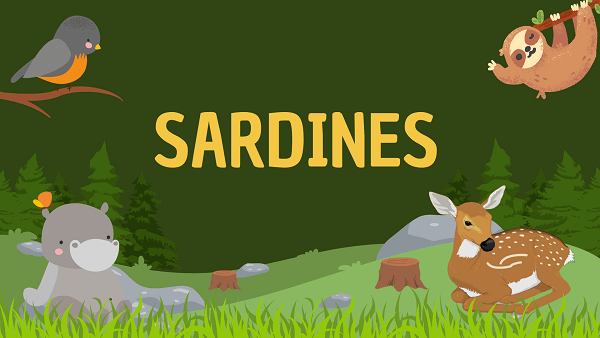Sardines | Facts, Diet, Habitat & Pictures
Home » Animals » Sardines | Facts, Diet, Habitat & Pictures
Sardines Overview
Appearance
Sardines, small silver fish, shimmer with metallic scales, forming tight schools in ocean depths. Their sleek bodies display iridescent hues, blending seamlessly with the aquatic world.
These slender creatures possess a distinct streamlined shape, allowing them to navigate swift currents with ease. In motion, they appear as a synchronized ballet of glimmers, an integral part of marine ecosystems.
Origins And Evolution
Sardines, believed to have originated in the warm waters of the Mediterranean, trace their evolutionary lineage back millions of years. Fossil records suggest their existence during the Eocene epoch. These small, oily fish belong to the Clupeidae family, a diverse group of marine species.
Over time, sardines adapted to various oceanic environments, leading to the emergence of different subspecies. Their evolutionary path favored traits such as streamlined bodies for efficient swimming and the development of specialized organs to detect predators and prey.
As they evolved, sardines also formed complex social structures, gathering in large shoals for protection and reproductive purposes. Their ability to reproduce prolifically and thrive in nutrient-rich waters contributed to their widespread distribution across oceans, making them a vital component of marine ecosystems and a valuable resource for humans throughout history.
Behavior and Lifestyle
It exhibits a highly social and gregarious behavior, forming immense schools that shimmer and move in coordinated unison. They are diurnal, typically active during daylight hours, and retreat to deeper waters at night for protection from predators.
These fish are filter feeders, relying on their specialized gill rakers to capture plankton and small prey. Their tight-knit shoals provide safety from larger predators, while the collective movement enhances their foraging efficiency.
Also engage in seasonal migrations, following ocean currents and temperature gradients, a lifestyle strategy that has allowed them to thrive in diverse marine environments worldwide.
Scientific Classification
- Kingdom: Animalia (Animals)
- Phylum: Chordata (Chordates)
- Subphylum: Vertebrata (Vertebrates)
- Class: Actinopterygii (Ray-finned Fishes)
- Order: Clupeiformes (Herring-like Fishes)
- Family: Clupeidae (Herrings and Sardines)
- Genus: Sardina (Sardines)
- Species: Various species of Sardina
Locations
- Mediterranean Sea
- Atlantic Ocean
- Pacific Ocean
- Indian Ocean
- Black Sea
- Gulf of Mexico
- California coast (USA)
- North Sea
- South China Sea
- Arabian Sea
Fast Facts
- Name: Sardines
- Scientific Name: Various species (e.g., Sardinops)
- Habitat: Open Oceans, Coastal Waters
- Diet: Plankton, Small Fish
- Physical Features: Silver Scales
- Nocturnal: Diurnal Migrations
- Solitary: Schooling Behavior
- Unique Order: Clupeiformes
- Lifespan: 3-5 Years
- Conservation Status: Varies by Species
- Fun Facts: Form Massive Schools, Important Fisheries
Physical Characteristics
- Color: Silver with iridescent scales
- Skin Type: Covered in small, overlapping scales
- Top Speed: Up to 25 miles per hour (40 kilometers per hour)
- Lifespan: Typically 3-5 years
- Weight: Usually 2-6 ounces (60-170 grams)
- Length: Generally 6-12 inches (15-30 centimeters)
- Age of Sexual Maturity: Typically around 1-2 years old
- Age of Weaning: Approximately 3-6 weeks
Sardines FAQs
What are sardines?
They are small, oily fish that belong to the Clupeidae family. They are known for their silver color and are often found in large schools.
Where do sardines live?
Sardines can be found in both coastal and open ocean waters around the world. They prefer warmer waters and are often associated with the Mediterranean Sea.
Are sardines and pilchards the same?
Sardines and pilchards are closely related fish, and the terms are often used interchangeably. The distinction between them can vary by region and size.
What do sardines eat?
It feeds on plankton, small fish, and crustaceans. Their diet consists of tiny marine organisms.
How long do sardines live?
The lifespan of sardines typically ranges from 3 to 5 years, depending on the species and environmental conditions.


